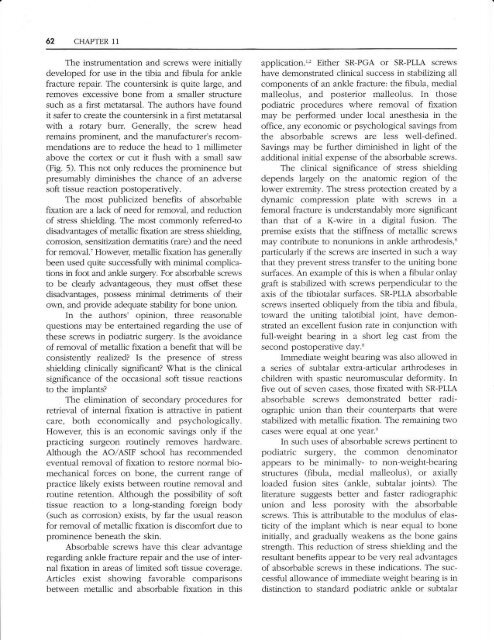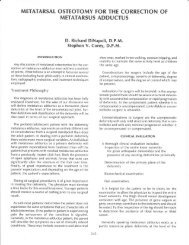Absorbable Screw Fixation - The Podiatry Institute
Absorbable Screw Fixation - The Podiatry Institute
Absorbable Screw Fixation - The Podiatry Institute
You also want an ePaper? Increase the reach of your titles
YUMPU automatically turns print PDFs into web optimized ePapers that Google loves.
62 CHAPTER 11<strong>The</strong> instnrmentation and screws were initiallydeveloped for use in the tibia and fibula for anklefracture repair. <strong>The</strong> countersink is quite large, andremoves excessive bone from a smaller structuresuch as a first metatarcal. <strong>The</strong> authors have foundit safer to create the countersink in a first metatarsalwith a rotary burr. Generally, the screw headremains prominent, and the manufacturer's recommendationsare to reduce the head to 1 millimeterabove the coftex or cut it flush with a small saw(Fig. 5). This not only reduces the prominence butpresumably diminishes the chance of an adversesoft tissue reaction postoperatively.<strong>The</strong> most publicized benefits of absorbablefixation are a lack of need for removal, and reductionof stress shielding. <strong>The</strong> most commonly referred-todisadvantages of metallic fixation are stress shielding,corrosion, sensitization dermatitis (rare) and the needfor removal.T However, metallic fixation has generallybeen used quite successfully with minimal complicationsin foot and ankle surgery. For absorbable screwsto be clearly advarrtageous, they must offset thesedisadvantages, possess minimal detriments of theirown, and provide adequate stability for bone union.In the authors' opinion, three reasonablequestions may be entefiained regarding the use ofthese screws in podiatric surgery. Is the avoidanceof removal of metallic fixation a benefit that will beconsistently realized? Is the presence of stressshielding clinically significant? Vhat is the clinicalsignificance of the occasional soft tissue reactionsto the implants?<strong>The</strong> elimination of secondary procedures forretrieval of internal fixation is attractive in patientc re, both economically and psychologically.However, this is an economic savings only if thepracticing surgeon routinely removes hardware.Although the AO/ASIF school has recommendedeventual removal of fixation to restore normal biomechanicalforces on bone, the current range ofpractice likely exists between routine removal androutine retention. Although the possibility of softtissue reaction to a long-standing foreign body(such as corrosion) exists, by far the usual reasonfor removal of metallic fkation is discomfort due toprominence beneath the skin.<strong>Absorbable</strong> screws have this clear advantageregarding ankle fracture repair and the use of internalfixation in areas of limited soft tissue coverage.Articles exist showing favorabte comparisonsbetween metallic and absorbable fixation in thisapplication.',' Either SR-PGA or SR-PLLA screwshave demonstrated clinical success in stabilizing allcomponents of an ankle fracture: the fibula, medialmalleolus, and posterior malleolus. In thosepodiatric procedures where removal of fkationmay be performed under local anesthesia in theoffice, any economic or psychological savings fromthe absorbable screws are less well-defined.Savings may be further diminished in light of theadditional initial expense of the absorbable screws.<strong>The</strong> clinical significance of stress shieldingdepends laryely on the anatomic region of thelower extremity. <strong>The</strong> stress protection created by adynamic compression plate with screws in afemoral fracture is understandably more significantthan that of a K-wire in a digital fusion. <strong>The</strong>premise exists that the stiffness of metallic screwsmay contribute to nonunions in ankle afthrodesis,'particularly if the screws are insefied in such a waythat they prevent stress transfer to the uniting bonesurfaces. An example of this is when a fibular onlaygraft is stabilized with screws perpendicular to theaxis of the tibiotalar surfaces. SR-PLLA absorbablescrews inserted obliquely from the tibia and fibula,toward the uniting talotibial joint, have demonstratedan excellent fusion rate in conjunction withfull-weight bearing in a short leg cast from thesecond postoperative day.'Immediate weight bearing was also allowed ina series of subtalar extra-articular arthrodeses inchildren with spastic neuromuscular deformity. Infive out of seven cases, those fixated with SR-PLLAabsorbable screws demonstrated better radiographicunion than their counterparts that werestabilized with metallic fixation. <strong>The</strong> remaining twocases were equal at one year.eIn such uses of absorbable screws peftinent topodiatric surgery, the common denominatorappears to be minimally- to non-weight-bearingstructures (fibula, medial malleolus), or axiallyloaded fusion sites (ankle, subtalar joints). <strong>The</strong>literature suggests better and faster radiographicunion and less porosity with the absorbablescrews. This is attributable to the modulus of elasticityof the implant which is near equal to boneinitially, and graduaily weakens as the bone gainsstrength. This reduction of stress shielding and theresultant benefits appear to be very real advantagesof absorbable screws in these indications. <strong>The</strong> successfulallowance of immediate weight bearing is indistinction to standard podiatric ankle or subtalar

















